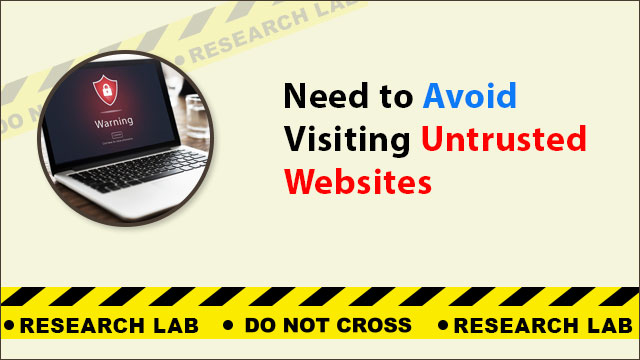Why Do We Need to Avoid Visiting Untrusted Websites?

Introduction: In this guide, we will discuss why do we need to avoid visiting untrusted websites.
While there are several legal websites with good cybersecurity safeguards in place, there are also a large number of bad websites design purely for the purpose of causing harm.
Hackers are active 24 hours a day, attempting to exploit flaws or trick people into facilitating access to their personal information—and they are astonishingly successful.
True, there are some recommended practices that everyone can and should follow to prevent this situation, such as never clicking on strange links or downloading anything from an unknown source. However, hackers nowadays are significantly more adept than they were before. They have the ability to infect your computer without you having to click on anything.
What are untrusted websites?
We visit several websites on a regular basis, and it’s critical to know which ones are secure. A untrusted website is one that is designed with the intent of stealing data from users. These malicious websites frequently look legal websites, and your computer might infect simply by browsing one. You might well prompt to download software that appears to require by your computer. A risky installation might risk your equipment and important data.
Why do we need to avoid visiting untrusted websites?
Here are some things that can happen if you visit an untrusted website:
A drive-by-download may cause all of the harm that an untrusted download can, but for one critical difference: it does not require your consent. Whenever you open on an untrusted download, you are granting the application express permission to install on your computer. However, drive-by downloads circumvent all of this and automatically install themselves on your machine without your consent. Hackers can install software on websites that monitors for vulnerabilities and exploits them immediately, resulting in drive-by downloads to your PC.
Despite its simplicity, URL injections have been shown to be quite effective. In order to enter a popular blogging site like WordPress, hackers insert malicious URLs into a web page – and in extreme cases, they can take over the entire page. An attack like this is activate when you visit it via a web browser. It can link you to other dangerous sites or download malware into your machine. Malicious redirection and browser hijackers are also use to drive you to visit other malware-infected websites.
That’s not all: phishing websites frequently appear as legitimate websites, such as Amazon or eBay, in which you would ordinarily submit your credit card information. It’s another highly persuasive method of persuading you to provide your info.
How to check website is trusted and safe?
- If you notice “HTTP” without the “S,” this indicates that the website lacks a certain sort of protection (an SSL certificate). The secured layer safeguards data transmitted between the server and the user. Owners of websites who actively seek clients and customers take care to use the appropriate encryption solutions. Otherwise, submitting credit card or other sensitive details may pose security hazards. Ascertain that the URL you are viewing has a “HTTP.”
- SSL encryption can be shown by a trust indicator (often in the shape of a lock and located in the upper left corner of a domain name). Additionally, it may refer to additional security methods. For instance, trust icons might convey information about the most recent malware scan conducted on the site. Trust symbols might be misleading, as not all of them are genuine. To ascertain credibility, click on the trust icon and check to see whether it takes you to a verification page. If this is the case, you may wish to verify the verification page’s legitimacy. You may accomplish this by conducting research on the security provider indicated on the verification page.
- When inspecting a URL, scan to determine whether any letters appear to be missing. Alternatively, there may be a typographical error or a significant grammatical problem. Alternatively, a letter might have substitute for a digit. For instance, the letter “L” may have use for the number “1”. These indicators point to a possible scam.
- Websites that provide an email address, a phone number, social media profiles, and other contact information indicate the credibility of the website. Contact information demonstrates that consumers may communicate with a live person in the case of fraud or a severe problem.
In Conclusion
Regardless of the business in which you operate, malware continues to pose a major danger. Untrustworthy websites and shady websites can be detrimental to a business. Understanding how to identify fraudulent URLs and websites might help you avoid damage.
It’s always wise to take precautions and avoid being a victim of online fraud.